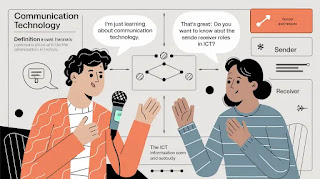A Deep Dive into Information and Communication Technology (ICT)
In today’s technology-driven world, understanding Information and Communication Technology (ICT) is crucial. As academics integrate more technology into learning, grasping ICT concepts becomes essential for success in exams like the UGC NET. This article provides a comprehensive guide to the ICT unit in UGC NET Paper 1, covering key definitions, concepts, and exam-related details to help you excel.
Decoding ICT: Information Technology vs. Communication Technology
Understanding the Components of ICT
ICT stands for Information and Communication Technology. This term combines two major fields.
Information Technology (IT): This refers to the use of technology for storing, processing, and collecting data. Examples include computers, software, and databases.
Communication Technology (CT): This deals with the technology used for sending and broadcasting information. This includes mobile phones, the internet, and various media formats.
When you merge IT and CT, you get ICT, which encompasses collecting, processing, storing, and sharing data globally through networks.
The Importance of Defining ICT in the Context of UGC NET
Understanding ICT's definition is vital for UGC NET success. Questions often test your ability to distinguish key components. For example, an exam might ask which option is part of ICT, requiring clarity on terms and concepts.
Real-world Applications of ICT
ICT is everywhere. It influences fields like education, healthcare, business, and more. For instance, e-learning platforms use ICT to deliver lessons globally, while telemedicine consults allow health professionals to reach patients remotely. Recognizing these applications is crucial for contextual understanding.
Understanding the Computer: Definition, Characteristics, and Types
Defining the Computer for UGC NET Exam Success
A computer is an electronic device that takes raw data as input, processes it, and presents the output. Recognizing this broad definition is critical as exam questions can frame computer functionality in various ways.
Key Characteristics of Computers
Several key characteristics define how computers function:
- Speed: Computers perform millions of calculations in seconds.
- Diligence: They maintain consistency without fatigue.
- Versatility: Use in various applications from gaming to data analysis.
- Accuracy: High precision with minimal errors.
- Reliability: Dependable in executing tasks.
- Memory: Ability to store vast amounts of data.
It's essential to note that despite their capabilities, computers lack emotional intelligence and autonomy; they operate based on human input and instructions.
Modern Computer Systems: Beyond Desktops and Laptops
Today’s computers come in various forms beyond traditional PCs and laptops. Examples include barcode scanners, ATMs, gaming consoles, smartphones, smartwatches, and smart TVs. All these devices function as computers by processing inputs and presenting outputs, broadening your understanding of technology.
Input and Output Devices: Beyond the Basics
Essential Input Devices and their Functions
Input devices allow users to enter data into a computer. Common examples include:
- Mouse: Used for navigation and selecting items on the screen.
- Keyboard: Primary tool for typing and commands.
Understanding Output Devices and their Applications
Output devices are responsible for displaying processed data. Key examples include:
- Monitors: Show visual output.
- Printers: Produce hard copies of digital documents.
Advanced Questions on Input/Output Devices
Exam questions often delve deeper than mere definitions. For instance, you might be asked about specific technical details like the number of keys on a keyboard or the full form of DPI (dots per inch). Familiarizing yourself with these details will prepare you for tricky exam questions.
The Central Processing Unit (CPU): Architecture and Function
CPU as the Brain of the Computer
The CPU, or Central Processing Unit, is vital for processing information. It processes input data and directs operations, making it a central element of computers.
Control Unit (CU) and Arithmetic Logic Unit (ALU)
The CPU has two main components:
- Control Unit (CU): Directs operations within the computer.
- Arithmetic Logic Unit (ALU): Handles calculations and logical operations.
Understanding these roles is crucial, as questions about CPU functionality frequently appear in exams.
Practical Application and Example Questions
Expect to see exam questions about how the CPU processes information. Familiarity with CU and ALU functions will give you an edge in answering these questions accurately.
Memory and Data Conversion
Types of Computer Memory
Memory types play a significant role in how a computer operates. Key types include:
- RAM (Random Access Memory): Temporary storage for active data.
- ROM (Read-Only Memory): Permanent storage used during startup.
Binary to Decimal and Decimal to Binary Conversions
Understanding conversions between binary and decimal systems is essential for problem-solving. For example, converting the binary number 1010 to decimal results in 10. Familiarize yourself with these processes to handle related exam questions confidently.
Relevance to UGC NET Paper 1
These memory concepts and conversion skills are vital for UGC NET. Being adept at topics like these ensures you can tackle various questions effectively.
Conclusion
This article highlighted the key aspects of ICT in UGC NET Paper 1. From understanding ICT components to exploring computer characteristics and CPU functions, mastering these concepts is crucial for exam success. Dive deeper into each topic and actively utilize this knowledge. Prepare well, and you’ll be on your way to acing UGC NET Paper 1.






